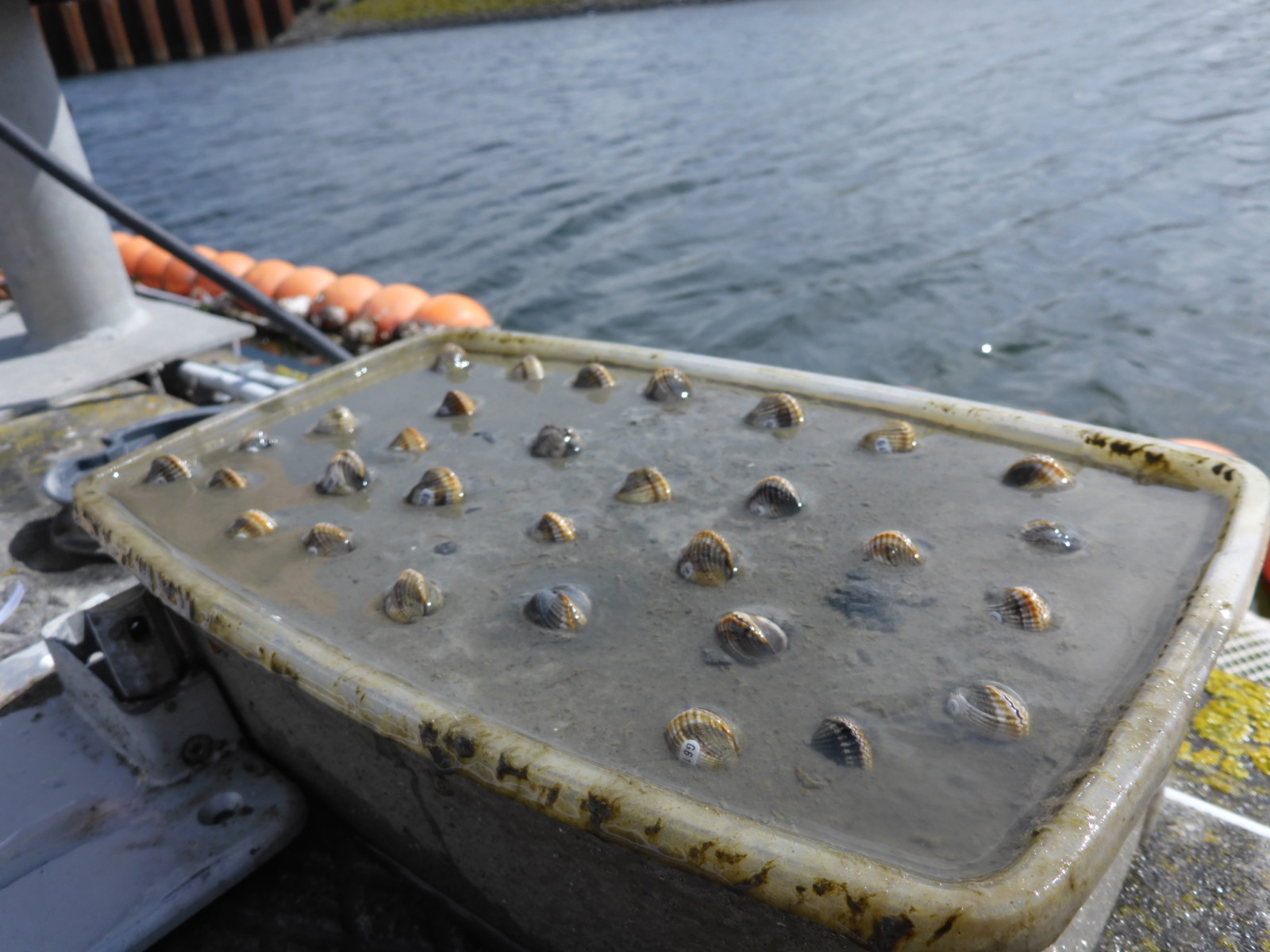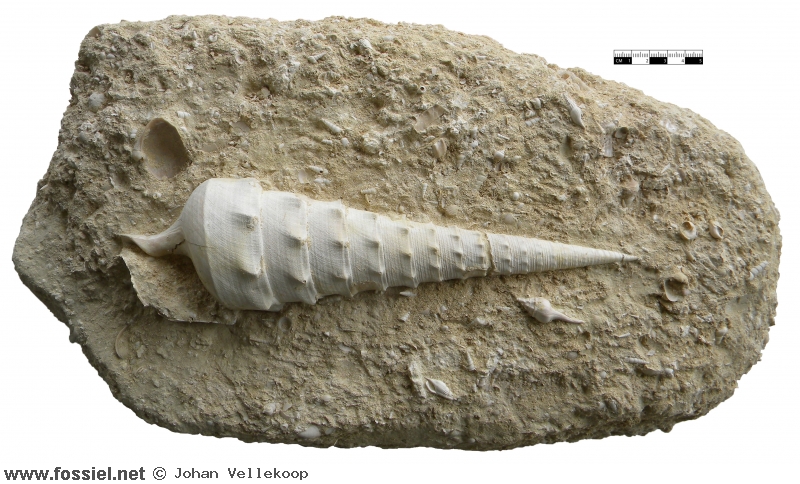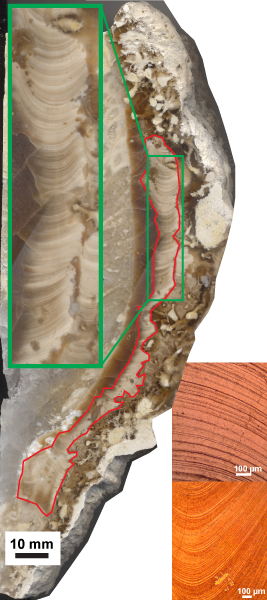
This is a solicited blogpost written by Niels de Winter.
Now that the effects of rising anthropogenic CO2 emissions are starting to affect our everyday lives, accurate reconstructions of past climates become more and more relevant. These reconstructions help us to improve climate models used to project future global warming scenarios which in turn inform policy makers. The further we look back in our geological past, the harder it becomes to reconstruct climate change at resolutions beyond thousands or millions of years. However, it is these high-resolution changes on the scale of decades or seasons that are arguably the most relevant in our efforts to understand climate change on the human timescale.
Fast-growing carbonates, such as the shells of mollusks, offer a solution to this. Many invertebrates leave distinct time markers in their shells in the form of growth layers, much like tree rings. The chemical composition of these changes in function of the animal’s changing environment. Since carbonates fossilize much better than, for example, trees or ice cores, these fossils offer a unique glimpse at short-term variability in past climates. This is where my colleagues and I aim to improve the crucial final interpretive step from chemical measurements in fossil shells to actual paleoclimate reconstructions: UNBIAS (“UNravelling BIvAlve Shell chemistry”; jointly funded by the Euopean Commission’s MSCA program and Flemish funder FWO) uses novel techniques for high-resolution chemical analyses, such as micro-X-ray Fluorescence scanning (see [1] and Fig. 1) and Laser Ablation ICP-MS (see [2]) to capture small-scale changes in the shell’s chemistry.

Fig. 2: Picture showing bivalves (in this case the common cockle Cerastoderma edule) are grown in a monitored and controlled environment in order to study the link between their shell chemistry and environmental change (photo credit: Sterre van Sikkeleras).
In addition to these high-resolution chemical analyses, we use modern bivalves in growth experiments. This teaches us how to read shell chemical and structural changes and how to link shell chemistry in fossils to past climates ([3] and Fig. 2).
Combining these high-resolution biological, chemical and geological techniques can lead to surprising new insights, for example:
- Higher seasonal temperature variability during the warm Eocene period (~45 million years ago), because the summers warm up faster than the winters ([4]). This led to balmy temperatures in the Paris Basin in what is now northern France, which was a hotspot of marine biodiversity with enormous sea snails (perhaps the largest ever to live) growing shells exceeding half a meter in just a few years (see 3)!

Fig. 3: Example of a fossil giant marine gastropod (Campanile symbolicum) from the warm Eocene period (45 million years ago) which grew very large shells (> 50 cm) in only a few years, making it one of the fastest growing mollusks in the fossil record (photo credit: dr. Johan Vellekoop, KU Leuven).
- Highly precise sampling along daily growth laminae in rudists (an extinct family of bivalve shells that built reefs much like corals do today ([5]; see 4) yield information about environmental variability on the scale of individual days during the Late Cretaceous period (~75 million years ago). This also indicated that these bivalves likely used photo symbionts to sustain themselves, living off the sunlight much like corals do.
- Based on the work with daily growth laminae in rudists ([5]), we also discovered that the year was 7 days longer than today, which is valuable information for astronomers interested in the evolution of the Earth-Moon system.

Fig. 4: Cross section through the shell of a rudist bivalve (species: Torreites sanchezi; 75 million years old), with the red polygon encircling the best-preserved part of the shell. The green insert and microscope images in the bottom right show the fine (30-40 µm wide) lamination formed with daily frequency.
The latest frontier in high-resolution paleoclimate reconstructions is the application of clumped isotope analysis for seasonal temperature reconstructions. These reconstructions are much more accurate than previous methods but require larger samples, which is a problem when working on millimeter-scale layers in fossil shells. Fortunately, a combination of analytical advancements and smart use of statistics now allows us to use this technique for seasonal-scale reconstructions [6]. The results are very promising, yielding information about seasonal variability in both temperature and sea water chemistry. The latter is especially poorly constrained in the geological past, and many climate reconstructions rely on assumptions about this parameter, so reconstructions like these are bound to shake up our understanding of past climates in the near future!
References:
[1] de Winter, N. J., Sinnesael, M., Makarona, C., Vansteenberge, S. & Claeys, P. Trace element analyses of carbonates using portable and micro-X-ray fluorescence: performance and optimization of measurement parameters and strategies. Journal of Analytical Atomic Spectrometry 32, 1211–1223 (2017), https://doi.org/10.1039/C6JA00361C.
[2] de Winter, N. J. et al. Shell chemistry of the boreal Campanian bivalve Rastellum diluvianum (Linnaeus, 1767) reveals temperature seasonality, growth rates and life cycle of an extinct Cretaceous oyster. Biogeosciences 17, 2897–2922 (2020), https://doi.org/10.5194/bg-17-2897-2020.
[3] Ballesta-Artero, I. et al. Environmental and biological factors influencing trace elemental and microstructural properties of Arctica islandica shells. Science of the Total Environment 645, 913–923 (2018), https://doi.org/10.1016/j.scitotenv.2018.07.116.
[4] de Winter, N. J. et al. The giant marine gastropod Campanile giganteum (Lamarck, 1804) as a high-resolution archive of seasonality in the Eocene greenhouse world. Geochemistry, Geophysics, Geosystems 21, e2019GC008794 (2020), https://doi.org/10.1029/2019GC008794.
[5] de Winter, N. J. et al. Subdaily-Scale Chemical Variability in a Torreites Sanchezi Rudist Shell: Implications for Rudist Paleobiology and the Cretaceous Day-Night Cycle. Paleoceanography and Paleoclimatology 35, e2019PA003723 (2020), https://doi.org/10.1029/2019PA003723.
[6] de Winter, N. J. et al. First absolute seasonal temperature estimates for greenhouse climate from clumped isotopes in bivalve shells. Nature Communications in review, (2020), https://www.researchsquare.com/article/rs-39203/v2.
Author:
Niels de Winter obtained his PhD at the Free University of Brussels (VUB, Belgium) and is currently jointly affiliated with the VUB and Utrecht University (the Netherlands) as a postdoctoral researcher. Parts of the work within the UNBIAS project are carried out at the Royal Dutch Institute for Sea Research (NIOZ, the Netherlands) and the University of Mainz (Germany). His research focuses on reconstructing seasonal changes in past climates using chemical and microscopic analyses on fossil mollusk shells and other high-resolution climate archives.

